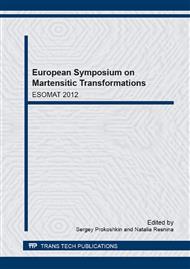p.257
p.262
p.269
p.274
p.276
p.281
p.287
p.292
p.297
Identification and Interpretation of Material Parameters of a Shape Memory Alloy (SMA) Model
Abstract:
The thermomechanical behavior of Shape Memory Alloys (SMAs) is described by many micromechanical and phenomenological models. The first ones have material parameters whose physical meaning is based on the crystallography of the phase transformation related to the studied alloy. In contrast, phenomenological models often have material parameters whose physical meaning is not obvious and that makes them difficult to identify, some of which are based on mathematical considerations. In this paper, we propose to use the formulation of the phenomenological model of Chemisky et al., and to consider the particular case of a superelastic SMA. In this case, the constitutive equation should be easily expressed analytically through the strain tensor as a function of applied load direction and material parameters. The behavior is then characterized by a complete and proportional loading. This analytical model contains 8 material parameters, 2 related to the elasticity and 6 to the phase transformation. Based on several isothermal tensile tests at various temperatures, material parameters of this model are identified using the Levenberg-Marquardt algorithm and an analytical calculation of the sensitivity matrix. Their physical meaning and their influence on the thermomechanical behavior of the alloy studied are highlighted and discussed.
Info:
Periodical:
Pages:
276-280
Citation:
Online since:
January 2013
Price:
Сopyright:
© 2013 Trans Tech Publications Ltd. All Rights Reserved
Share:
Citation:


